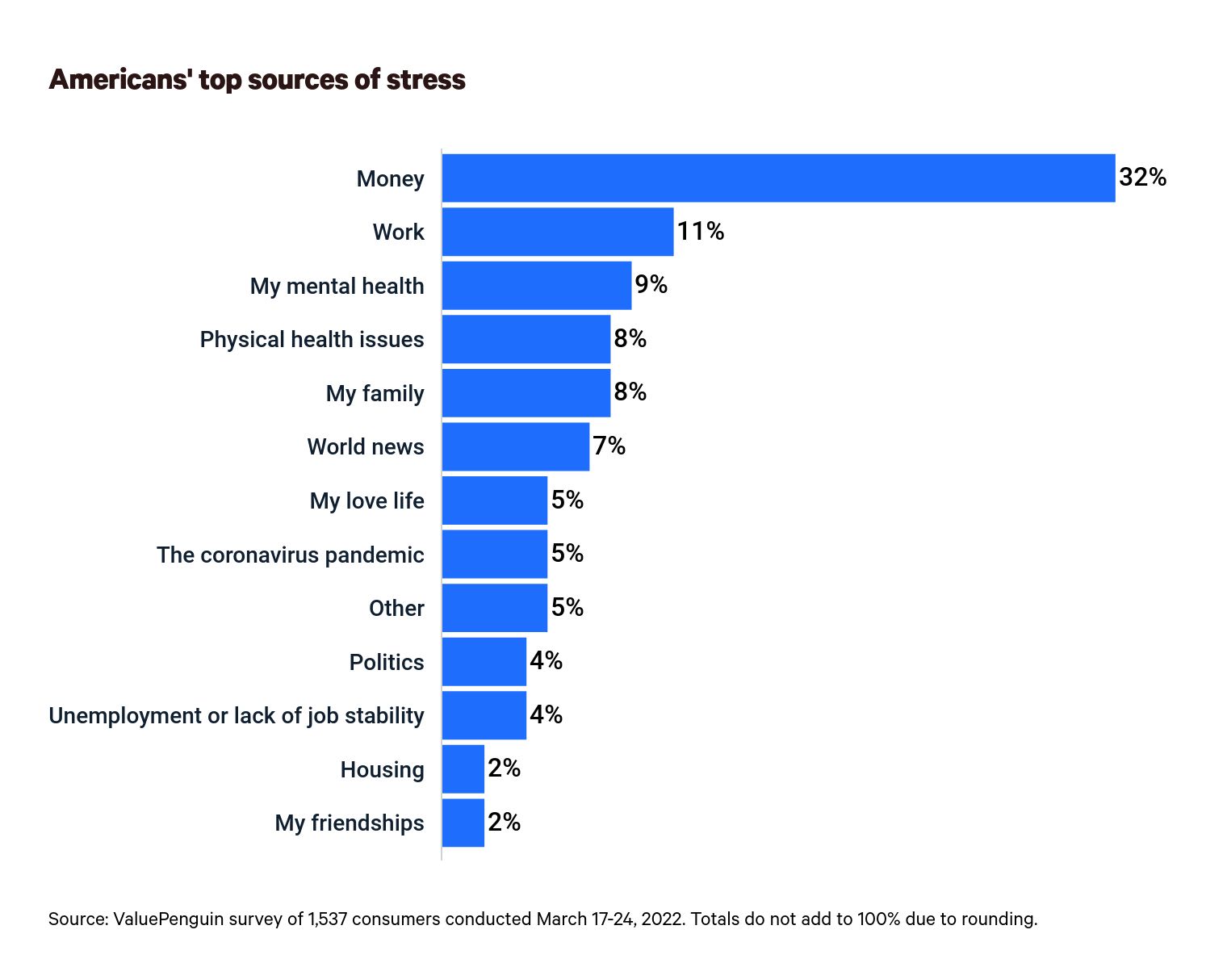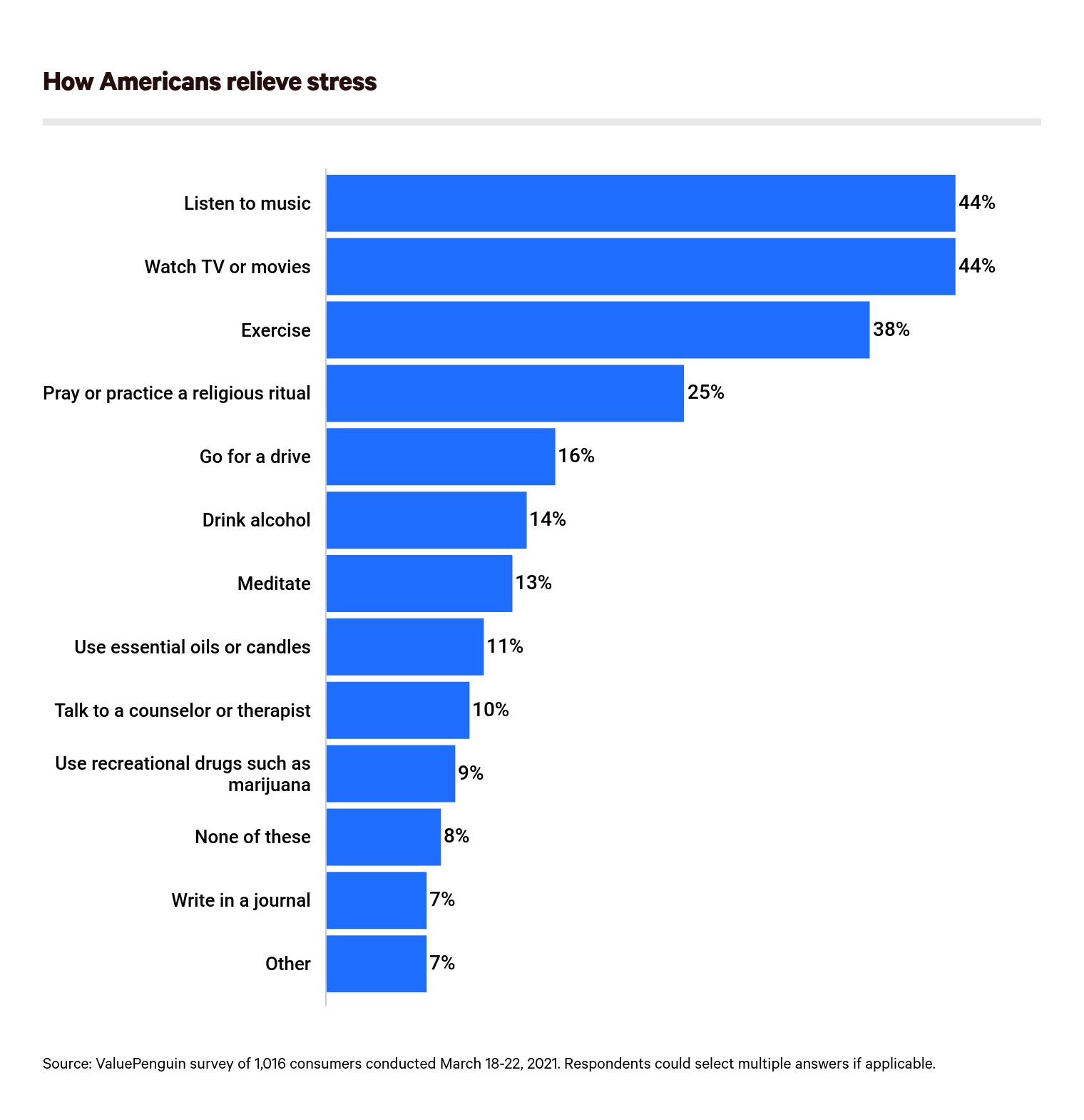Health Insurance
Americans’ Stress Levels — and Financial Anxiety — on the Rise

If stress is a normal part of your everyday life, you have company. In fact, 84% of Americans feel stressed at least once in a typical week, according to the newest ValuePenguin survey — up from 78% who reported the same in March 2021.
April is Stress Awareness Month, so ValuePenguin asked more than 1,500 Americans about their weekly stress levels and the underlying causes to supplement a survey we conducted last year. Here are the new results, as well as what we discovered last year.
2022 key findings
- Americans’ stress levels are higher than last year. 84% of Americans report feeling stressed weekly, up from 78% in March 2021.
- Money remains consumers’ top stressor, with consumers increasingly worried about their finances over their careers. 32% now say money is their biggest source of stress, up from 22% last year. Work takes the next spot at 11% (down from 14%).
2021 key findings
- Mondays and mornings are the most stressful times of the week, according to last year’s findings. 19% say their stress peaks on Monday, while 22% say they feel most stressed in the mornings.
- Depending on your age, the person who stresses you out the most is likely either your boss or your spouse or partner. Gen Zers and millennials both name their boss as their biggest source of stress, while Gen Xers and baby boomers say their spouse or partner causes them more stress than any other person.
- 44% of Americans say the pandemic has been the most stressful time in their entire life. This is especially true for those laid off or furloughed during the crisis (59%) and parents with kids younger than 18 (58%), as well as Gen Zers (54%) and millennials (51%).
- Consumers employ a variety of tactics to reduce stress. This includes watching TV/movies and listening to music (tied at 44%), exercising (38%), praying or another religious ritual (25%) and driving around (16%). Meanwhile, 14% drink alcohol to reduce stress and 9% use recreational drugs such as marijuana.
Americans’ stress levels on the rise
Chronic stress can cause a wide range of physical and mental health issues, from high blood pressure and heart disease to depression and anxiety. Yet many Americans can’t seem to escape these problems despite the dangers they pose. In fact, stress levels are on the rise.
According to a March 2022 ValuePenguin survey, 84% of Americans feel stressed at least one day in a typical week — a six percentage point increase from 78% in March 2021. Of the larger group, 15% say they’re stressed every day of the week.
- Stressed 0 days in a typical week: 16%
- Stressed 1 day in a typical week: 12%
- Stressed 2 days in a typical week: 16%
- Stressed 3 days in a typical week: 17%
- Stressed 4 days in a typical week: 9%
- Stressed 5 days in a typical week: 11%
- Stressed 6 days in a typical week: 3%
- Stressed 7 days in a typical week: 15%
Women experienced a more significant year-over-year shift in stress levels than men. The March 2022 data shows 92% of women feel stressed at least one day in a given week, up from 84% last year. (In comparison, 76% of men feel stressed at least one day in a given week, up from 72% last year.)
Age also appears to impact the amount of stress that individuals feel. In fact, 95% of Gen Zers (ages 18 to 25 in 2022) report being stressed at least one day a week — the highest among any demographic examined. Gen Zers are followed by:
- Millennials (ages 26 to 41): 92%
- Gen Xers (ages 42 to 56): 87%
- Baby boomers (ages 57 to 76): 68%
In this realm, Gen Zers saw a massive year-over-year change. While 95% of the group reported stress in 2022, that percentage was 77% last year — an 18 percentage point shift. According to an October 2021 survey from the American Psychological Association, Gen Z adults are most likely to say it’s now more stressful to make major life decisions than before the pandemic. Also, nearly 4 in 5 Gen Z adults report experiencing behavior changes — from avoiding social situations to altering physical activity levels — because of their stress in the past month.
"Although the height of the COVID-19 pandemic appears to be behind us, pandemic-related concerns persist," says Robin Townsend, a ValuePenguin health and life insurance expert. "In 2022, women and young people in particular — who already had higher stress levels — say they still feel health, financial and other stresses brought on by the pandemic."
The 2022 ValuePenguin survey also reveals that 90% of parents with kids younger than 18 report being stressed at least one day in a typical week, versus 85% of people without kids and 75% of parents with adult children.
Lastly, the income you earn may also affect your stress level. One-fifth of consumers who earn $35,000 or less a year feel stressed every day. And those who earn $100,000-plus annually feel daily stress about half as often (11%) as lower-income earners.
Money is still the top source of stress for Americans
There are many triggers in life that cause people to be stressed, but money (32%) holds the top spot for the second year in a row. And that financial anxiety is growing, as the percentage of Americans who cited money as their top stressor in last year’s ValuePenguin survey was 22%.
When last year’s survey was conducted, President Biden had just days before signed the American Rescue Plan into law. Within that plan were economic impact payments (or stimulus checks) of up to $1,400 per person for eligible Americans. That was the last round of stimulus checks, making it a possible contributing factor to why money is now a heightened stressor.
Beyond money, work (11%), mental health (9%) and physical health (8%) were cited as top stressors.

Both men and women saw increases in the percentage who cited money as a top stressor — women from 22% to 34% and men from 22% to 29%. Beyond money, men cited work the second-most, while women cited mental health.
Across the board by age, Americans cite money as their biggest source of stress, led by 38% of millennials. That’s followed by:
- 32% of Gen Xers
- 30% of Gen Zers
- 26% of baby boomers
In last year’s survey, millennials were more stressed about work (22%) than money (16%). That means the percentage of millennials who cited money as a top stressor jumped a whopping 22 percentage points year over year. (Work dropped from 22% to 14% among millennials.)
Millennials are often referenced as the job-hopping generation (though Gen Zers are putting up a challenge). A 2021 CareerBuilder survey found that millennials spend two years and nine months (on average) in a job role. With an increase in remote roles and flexibility amid the Great Resignation, it’s not surprising that millennials are now less concerned about work.
The second-most-cited stressor varied by age group:
- Gen Zers: Mental health
- Millennials: Work
- Gen Xers: Work and family (tie)
- Baby boomers: Physical health
And whether Americans make less than $35,000 a year or more than $100,000 a year, money is the top stressor. Of note, the highest earners are equally as concerned about work.
While our survey looked at wider categories, a March 2022 survey from the American Psychological Association pointed to specific recent events that are causing stress, from rising inflation (gas, groceries and everything in between) to supply chain issues to global uncertainty to Russia’s invasion of Ukraine.
That Monday morning feeling is real for many Americans
Note: From this point, the data referenced within is from the 2021 ValuePenguin survey.
We’ve highlighted how often people are stressed and what they’re stressed about, but what about when they’re stressed?
Monday is the most stressful day of the week, according to ValuePenguin survey respondents in 2021. In fact, 19% say their stress peaks on that day. Sunday comes in second but at a much lower 7%.
- Most stressed on Wednesdays: 5%
- Most stressed on Tuesdays: 5%
-
Most stressed on Fridays: 3%
- Most stressed on Thursdays: 3%
- Most stressed on Saturdays: 2%
- No specific day: 57%
Sterling Price, former ValuePenguin senior research analyst, says the weekend-to-work transition plays a role.
"Monday could be particularly difficult for people due to the beginning of the workweek and the subsequent end of the weekend," Price says. "As people return from having a stress-free and worry-free weekend, they’ll start to think about the things in their life that they need to get done during the coming week. Often, if these things are difficult tasks, then that will increase the amount of stress they feel."
Millennials — ages 25 to 40 in the 2021 survey — feel more stressed on Mondays than any other generation at 26%. Baby boomers — ages 56 to 75 in the 2021 survey — come in last at 14%, but this may be because more people within this age group are retired, so not as many face the typical start-of-the-workweek stress that many from younger generations experience.
The more money you make, the more stressed you feel on Mondays. That could be because those with higher incomes may be more likely to work traditional Monday-to-Friday 9-to-5 jobs. Meanwhile, Monday may not necessarily mark the beginning of the workweek for others.
Particular times of the day also appear to trigger higher stress levels. Overall, more than half of respondents say their stress peaks at certain times. Mornings, unsurprisingly, are the worst for many people, as 22% of Americans say they feel more stressed out in the mornings than any other time of day.
- Afternoons: 19%
- Evenings: 13%
- Other time of day: 2%
- No specific time: 45%
Gen Zers — ages 18 to 24 in the 2021 survey — hate mornings more than any other age group — with 35% citing it as the most stressful time of day. However, only 13% of baby boomers feel the same, with 61% in this age group saying that no specific time of day is more stressful than another for them.
Again, there’s a chance that other factors — including retirement and the absence of younger children in the home — could have an impact here. In many cases, baby boomers may no longer have to rush off to work in the morning or prepare young children for school.
These are the people who stress Americans out
The people in your life may also be a large source of stress. When the 2021 ValuePenguin survey asked respondents if a specific person stresses them out the most, 14% named their spouse/partner, while 10% cited their boss.

The person who causes you the most stress can also vary by age:
- Gen Zers: Boss (19%) and parents (19%)
- Millennials: Boss (16%)
- Gen Xers (ages 41 to 55 in the 2021 survey): Spouse/partner (16%)
- Baby boomers: Spouse/partner (13%)
In some cases, the right health insurance policy might be able to eliminate or at least reduce the impact of certain stressors. Your policy could help by providing the medical coverage you need to address physical and mental health challenges.
Many Americans have never been as stressed in their lives as they have been during the COVID-19 crisis
For many people, coping with stress has never been more of a challenge than it has been during the coronavirus pandemic. In fact, 44% of Americans said in the 2021 survey that the pandemic was the most stressful time in their entire life. (A year later, we’re still in a pandemic.)
Although feelings of stress are high across the board, they’re especially strong for the following groups:
- Those who were laid off or furloughed (59%) during the COVID-19 crisis
- Parents with kids younger than 18 (58%)
- Gen Zers (54%)
- Millennials (51%)
Price recommends people seek help to handle their stress, including talking to a therapist.
Your health insurance may be able to help here.
"Most often, if you do have health insurance — either through the Obamacare marketplace or through your company — there will be in-network providers for therapy that will definitely aid you in managing that stress," Price says.
>> 61% of Americans trying to break unhealthy pandemic habits
How Americans relieve stress: Music, TV, exercise and more
Americans turn to a number of different outlets in an attempt to deal with the stress they feel.

Only 10% of respondents say they rely on a counselor or therapist to cope with stress. And those who do reach out for professional therapy or counseling are more likely to be women than men.
As for coping mechanisms that could cause more harm than good, 14% drink alcohol to reduce stress and 9% use recreational drugs such as marijuana. Millennials are more likely than other age groups to turn to those two.
Most of all, it’s important not to try to sweep feelings of stress aside or bury them. Reach out to loved ones and family if you’re having increased stress, depression or loneliness. And, of course, talk to your doctor openly about your stress and mental health, especially amid a pandemic. If you need further help, here’s the best insurance for mental health.
Methodology
ValuePenguin commissioned Qualtrics to conduct an online survey of 1,537 consumers March 17-24, 2022, for updated data regarding how frequently Americans experience stress, as well as their top stressors. The rest of the data comes from a survey of 1,016 U.S. consumers conducted March 17-22, 2021. Both surveys were administered using a nonprobability-based sample, and quotas were used to ensure the sample base represented the overall population. All responses were reviewed by researchers for quality control.
We defined generations as the following ages in 2022:
- Generation Z: 18 to 25
- Millennial: 26 to 41
- Generation X: 42 to 56
- Baby boomer: 57 to 76
For the portion of the survey from last year, we defined generations as the following ages in 2021:
- Generation Z: 18 to 24
- Millennial: 25 to 40
- Generation X: 41 to 55
- Baby boomer: 56 to 75
While both surveys also included consumers from the silent generation (those 77 and older in 2022 and those 76 and older in 2021), the sample sizes were too small to include findings related to that group in the generational breakdowns.
